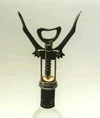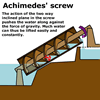The screw
 You can imagine the screw as an inclined plane wrapped around
a metal rod. This can be shown by wrapping a triangle of paper
round a pen and noting how the paper edge travels along the pen.
Attaching a nut to a bolt demonstrates that the nut moves up the
bolt by following a continuous path cut into the bolt. A wood
screw operates in a similar manner by pulling itself into a block
of wood as it turns. Because a nut on a bolt travels a greater
distance around the bolt, compared with the distance it moves
along the bolt, there is a great mechanical advantage and a great
force can be applied to the bolt with little effort.
You can imagine the screw as an inclined plane wrapped around
a metal rod. This can be shown by wrapping a triangle of paper
round a pen and noting how the paper edge travels along the pen.
Attaching a nut to a bolt demonstrates that the nut moves up the
bolt by following a continuous path cut into the bolt. A wood
screw operates in a similar manner by pulling itself into a block
of wood as it turns. Because a nut on a bolt travels a greater
distance around the bolt, compared with the distance it moves
along the bolt, there is a great mechanical advantage and a great
force can be applied to the bolt with little effort.
Using the screw
 The mechanical advantage of a screw can be put to good use
in many applications, one being a car jack. There are basically
two types of car jack, both of which use the screw mechanism.
One type is the scissor jack and the second is a bottle jack.
In the scissor jack the screw is used to pull together a diamond
shape with hinges top and bottom. As the screw is tightened the
hinged sections move apart.
The mechanical advantage of a screw can be put to good use
in many applications, one being a car jack. There are basically
two types of car jack, both of which use the screw mechanism.
One type is the scissor jack and the second is a bottle jack.
In the scissor jack the screw is used to pull together a diamond
shape with hinges top and bottom. As the screw is tightened the
hinged sections move apart.
 The cork screw works by inserting the sharp point of the screw
into the soft cork, forcing the screw into the cork by turning
and removing the cork by pushing down on the levers with the screw
embedded in the cork.
The cork screw works by inserting the sharp point of the screw
into the soft cork, forcing the screw into the cork by turning
and removing the cork by pushing down on the levers with the screw
embedded in the cork.
Archimedes' screw

Archimedes was a Greek inventor, mathematician and experimenter.
He experimented with simple machines like the lever and the pulley
making moving heavy objects so much easier. He used the principle
of the screw in his invention to raise water from a lower level
to a higher level.
The Archimedes Screw collects water at the lower
level and it flows from one spiral to the next finally emerging
at the top of the screw, depositing water at a higher level.